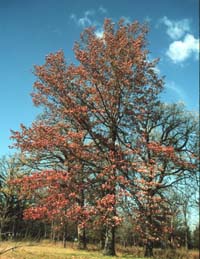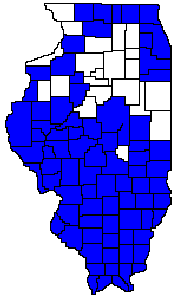 |
| Pin
Oak (Quercus palustris)
Distribution
Map to Right |

Pin oak typically grows to between 50 and 75 feet in height, with a trunk diameter of 1 to 3 feet. It has an oblong or rounded crown that becomes more irregularly open with age. The lower branches droop and are slowly lost, leaving pin-like, stubby branches.
Pin oak grows in moist, usually rich soils of bottomlands (palustris refers to marshes) in almost every county in Illinois. It is common in floodplains along streams and at the edges of swamps and ponds. Throughout the rest of its range from Massachusetts, west to southeastern Iowa and south to Oklahoma east to northern Virginia, it occurs in moist, clay soils.
Overall, it commonly grows on sites that flood occasionally, but not during the growing season. It grows on sites with a 'claypan' such as Illinois flatwoods, which tend to be very wet, with standing water at the surface in the winter and spring.
Interesting
Facts
Pin oak is very similar to Hill's or northern pin oak. It is distinguished from Hill's oak by its acorns, which are shorter and covered by a shallower cup than those of Hill's oak which are about twice as long and taper. The trees also differ in their habitat preferences. Whereas pin oak grows in moist, bottomland soils, Hill's oak prefers drier upland soils. Pin oak leaves turn red or brown in the fall and persist on the tree during the winter. Hill's oak leaves turn color and are shed in the autumn. The winter-persistent leaves and the pin-like stubs (which remain after the lower branches of pin oak are lost as the tree matures) are the most distinctive characteristics of the tree.
Identifying Features
BarkUses
Pin oak is a member of the red oak group. Its bark is lighter gray or reddish brown when young, becoming or darker gray brown when mature. It is smooth when young, developing shallow furrows as it ages.
Twigs
The twigs are slender and reddish brown to gray brown and shiny.
Buds
The buds are approximately 1/8 inch long, reddish brown and are sharp pointed.
Leaves
The leaves are alternate and simple, with 5-7 deeply incised, bristle-tipped lobes. They are up to 7 inches long and up to 4 inches broad, with a slender leaf stalk up to 2 inches long. They are dark green and shiny on the upper surface and paler with tufts of hair along the veins on the underside. Dead leaves tend to remain on the tree in the winter.
Flowers
Pin oak is monoecious; both male (staminate) and female (pistillate) flowers are borne on the same tree. The male flowers appear as catkins and the female flowers in groups of 1-3 just as the leaves begin to unfold.
Fruits
The acorns are 1/2 inch long and up to 1/2 inch across, and are borne singly or in groups of up to four. They can occur with or without stalks, and are nearly hemispherical in shape, the cup being thin and saucer-shaped. The nuts are often striate, and the cups are reddish brown and finely hairy or hairless.
Pin oak wood is hard and heavy. It is used for fence posts, fuel, and general construction. Because it is fast growing and tolerant of urban stresses, it is commonly planted as an ornamental.